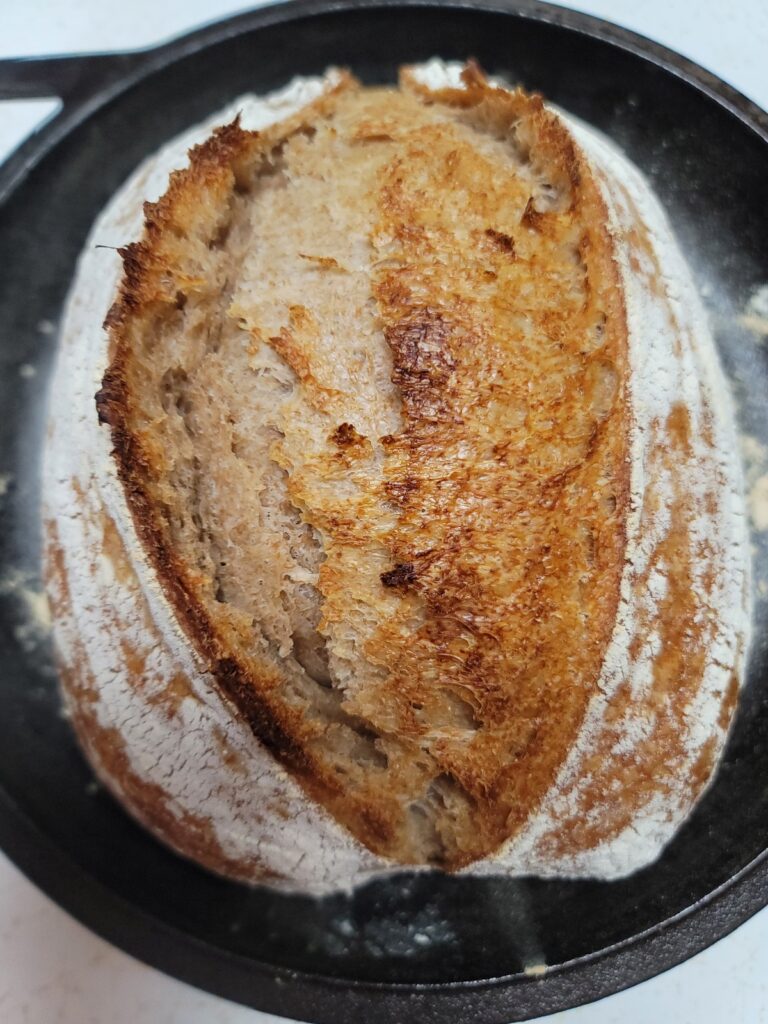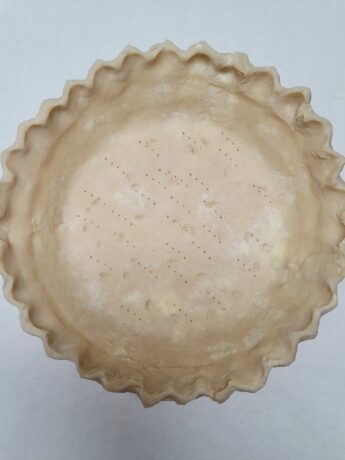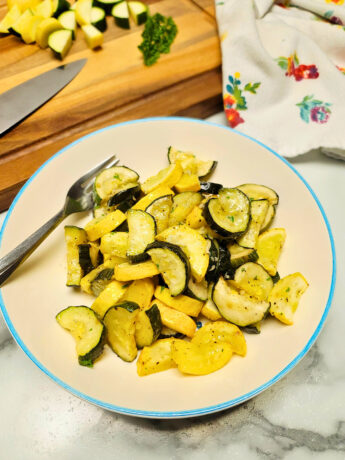A straightforward sourdough bread recipe that yields a great loaf of bread every time. While making sourdough takes a long time, it is relatively hands off. This loaf of sourdough takes about 24 hours from start to finish, and every second is worth it.

There is something quite therapeutic about baking a loaf of homemade sourdough bread. The quality is far better than any sourdough that you can buy from the store. Not to mention, you control what goes in it.
The entire process, from feeding the starter, stretching and folding the dough, fermenting, shaping and baking the dough, all become so natural and easier every time you do it. Your reward is the end result, a beautifully crusty loaf of delicious sourdough bread made by your very own hands!
This recipe is simple in terms of the flour used. Just bread flour and all-purpose flour. I recommend starting with these two flours if this is your first-time making sourdough bread. After you get the feel of making the bread then you can start to add in other flours like whole wheat or rye.

Why is Sourdough Bread so Popular?
Sourdough Bread is so popular because it is so easy to make and is healthier than your traditional sandwich bread.
The fermentation process that sourdough goes through make the bread much easier to digest than bread that is made without the fermentation process.
Making the dough the day before and allowing it to sit overnight in the refrigerator makes it easy to fit into my daily schedule. Which means I am baking my bread first thing in the morning. If baking your bread in the morning is not an option, you can adjust the times to fit your schedule.
I find that the best fermentation happens with at least 12 hours of resting in the refrigerator. However, you can bake in as little as 10 hours or even longer than 12 hours.
How to Tell is Your Sourdough Starter is Active
When making sourdough the most crucial part is making sure your starter is active and ready to be used. Without an active starter, your bread will not rise. Thankfully this is easy to check. I like to keep a rubber band on the jar that I keep my starter in. I put the rubber band where the starter is when I feed it. After it has set for a few hours, I can tell if the starter has risen, and by how much. This is a good way to see if your starter is becoming active.

Next you can tell by the bubbles on the surface of the starter, there will be a lot when the starter is active. The best way to check is to drop a little bit of the starter into a bowl of water, if the starter floats, then it is active and ready to use.
Equipment for Making Sourdough Bread
Kitchen scale is necessary in making sure you measure out the ingredients correctly.
Large mixing bowl is needed to allow the dough enough room to rise.
Bread Lame or razor blade to score the bread. If you do not have either of the two, a really sharp knife can be used.
Banneton is a basket used to proof bread in. You can use a bowl if you do not have a banneton.
Dutch Oven for baking the bread. Covering the dough as it bakes allows it to steam, which creates the super crusty crust. I use a Lodge Cast Iron Dutch Oven that I found on amazon. I absolutely love baking my sourdough in this dutch oven.

Bowl Scraper is your best friend when making anything with sourdough.
Sourdough Bread Schedule
Revised 10/21/2022: I have recently been letting my shaped sourdough ferment in the refrigerator for 24 hours. I have found that the rise is much better after 24 hours. The crust also seems to be softer when allowed to ferment for 24 hours. Happy Baking!
Below I have put together a schedule for making sourdough bread. Keep in mind that the entire process is dependent on a warm environment. If the environment is cold, it will take a lot longer for the entire process.
I use warm water when feeding my starter and put it on my stove with the stove light on. This helps the starter become active faster. When the kitchen is colder, I will keep my dough in the oven and periodically warm it up by turning the oven on for 10 to 15 seconds, just enough to warm it. I will do this every time I do a stretch and fold. Again, while it is bulk fermenting.
If your schedule is more flexible or it is warmer where you are making it, then you may not need to do these things. Also keep in mind that the entire schedule can vary depending on the amount of time it takes your starter to be fully active and ready to be used.
7 a.m Feed your starter.
12 p.m. Mix together the flour and water and set aside to autolyse.

1 p.m. Mix in the remaining ingredients. Begin the slap and fold technique. This a kneading technique used for wet doughs that are rather tricky to handle.
Tip
Keep a bowl of water nearby to help handle the sticky dough.
Begin by putting the dough onto a clean work surface. Dip your fingertips in the water, grabbing from the middle, pick the dough up with both hands. Slap it down onto the work surface then stretch it up towards your body and fold over the dough.

When picking the dough back up, grab from the middle, turn 90° and repeat the process for 5 minutes. The dough will start to smooth out as you knead.
Place the dough back into your bowl, cover with a damp towel or plastic wrap, place in a warm spot and let rest for 30 minutes.

1:35 p.m. Begin stretching and folding the dough.
With the dough still in the bowl, dip your fingers in the water and reach down into the bowl, grab the bottom of the dough firmly and pull up, stretching as far as the dough allows, and then fold it over to the other side.
Turn the bowl slightly and continue until all of the dough has been stretched and folded 1 time. Do this 6 times, allowing the dough to rest for 15 minutes in between the first 3 stretch and folds and 30 minutes in between the last 3 stretch and folds.


3:50 p.m. Cover and let rest to bulk ferment until doubled.
8 p.m. This time may vary, depending on how long it takes for your dough to double in size. Pour the dough out onto a lightly floured work surface. Being gentle to prevent deflating the bubbles in the dough.

Shape the dough by pulling the right side over onto the left side, then pulling the left side over onto the right side. Then pull the top up and back towards your body, using the dough to round out the dough and make the shape tight.
Place into a generously floured banneton with the seam side facing up. Dust with more flour, cover with plastic wrap or a towel and place in the refrigerator for at least 12 hours.

In The Morning
8:30 a.m. Preheat a dutch oven in a 500° F oven for 1 hour.
9:30 am Lightly flour the dutch oven and carefully drop in the dough, score with the bread lame, place the top of the dutch oven back on and place into the oven for 25 minutes. Remove the lid, lower the temperature to 450° F and bake for another 20 minutes. Remove from the oven and place on a wire rack to cool.

Now for the hard part, allow the bread to cool completely before slicing. Enjoy!
Should you let bread cool completely before slicing it?
Yes, you should always let your bread cool completely before slicing it. Slicing the bread before it properly cools will result in a sticky, gummy interior texture.
More Sourdough Recipes to Try!
Roasted Garlic and Rosemary Sourdough Bread
Handpicked Recipes









Follow Simply Scratch Made on Pinterest.
Tried This Recipe?
Leave a review below, I would love to hear how it turned out! ⭐⭐⭐⭐⭐
Sourdough Bread
The perfect sourdough recipe for beginners and seasoned bakers. This recipe yields a soft texture and deliciously tangy flavor. You will keep coming back to this recipe time and time again.


Ingredients
Instructions
-
Combine the warm water and flour, cover and allow to sit for 1 hour.
-
Mix in the remaining ingredients. Begin the slap and fold technique, continue for 5 minutes. Cover and set aside for 30 minutes.
-
Begin stretching and folding the dough. With the dough still in the bowl, dip your fingers in the water and reach down into the bowl, grab the bottom of the dough firmly and pull up, stretching as far as the dough allows, and then fold it over to the other side. Turn the bowl slightly and continue until all of the dough has been stretched and folded 1 time. Do this 6 times, allowing the dough to rest for 15 minutes in between the first 3 stretch and folds and 30 minutes in between the last 3 stretch and folds.
-
Cover and let rest to bulk ferment until doubled.
-
Remove from the bowl and place on a lightly floured work surface. Shape the dough by pulling the right side over onto the left side, then pulling the left side over onto the right side. Then pull the top up and back towards your body, using the dough to round out the dough and make the shape tight. Place into a generously floured banneton with the seam side facing up. Dust with more flour, cover with plastic wrap or a towel and place in the refrigerator for at least 12 hours.
-
Preheat a dutch oven in a 500° F oven for 1 hour.
-
Lightly flour the dutch oven and carefully drop in the dough, score with the bread lame, place the top of the dutch oven back on and place into the oven for 25 minutes. Remove the lid, lower the temperature to 450° F and bake for another 20 minutes. Remove from the oven and place on a wire rack to cool.





Love your recipes!!!!
Thank you!
This was so much easier to make than some of the other recipes I’ve tried. Thank you!
Glad you like the recipe!
Can’t wait to try this!
This bread was so delicious! I love that classic tang and texture. Thank you so much for including tools to make it easier, too. This was the first time I made sourdough bread without wanting to pull my hair out!
That’s awesome to hear! I know exactly what you mean, I’ve been there too!
Great tutorial! I have always been a little intimidated to try making sourdough but I am going to give it a go!
I loved this recipe, Sky! The instructions were clear and the sourdough was just a joy to make. It turned out perfectly. Thank you!
You are very welcome! I am so glad that you enjoyed making this sourdough recipe!
This sourdough bread looks absolutely amazing! I can’t wait to try this out.
Thank you!
I’ve tried a couple sourdough bread recipes to no avail. Tried this one and it was perfect! I love how my bread turned out!